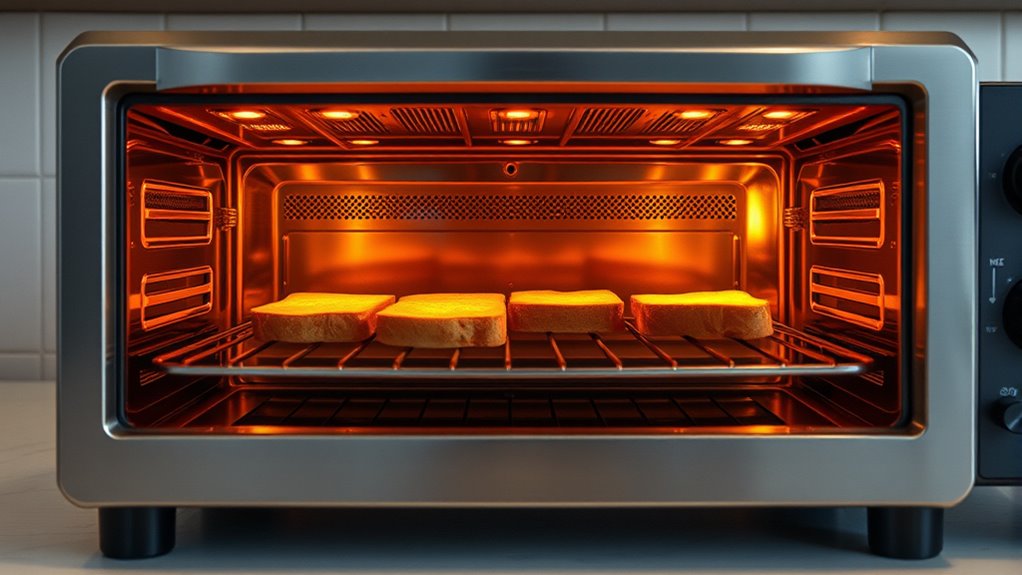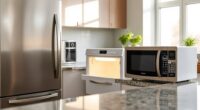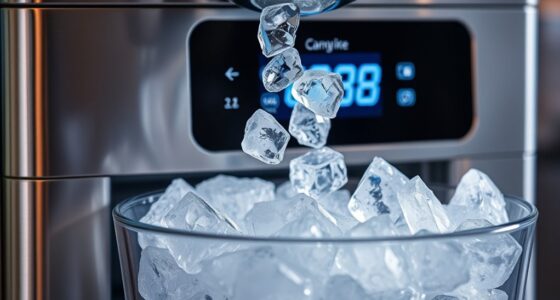Good temperature uniformity in your toaster oven guarantees your food cooks evenly, avoiding burnt edges or undercooked centers. When heat distribution is consistent, you get better texture, appearance, and taste, while also reducing cooking time and energy use. Non-uniform heating creates hot spots and cold zones, leading to inconsistent results and decreased satisfaction. Understanding these impacts can help you optimize your oven’s performance—if you keep exploring, you’ll discover how to improve temperature control even further.
Key Takeaways
- Uniform temperature ensures consistent cooking, reducing hot spots and cold zones for evenly browned and thoroughly cooked food.
- Improved temperature distribution shortens cooking times and decreases energy consumption by reducing the need for multiple cycles.
- High uniformity enhances food safety by ensuring proper heat exposure, effectively eliminating harmful bacteria.
- Consistent heat prevents over- or undercooking, leading to higher-quality results and increased user satisfaction.
- Better temperature uniformity simplifies operation, minimizes user errors, and extends appliance lifespan through efficient heat management.
Understanding the Role of Temperature Uniformity in Toaster Oven Functionality
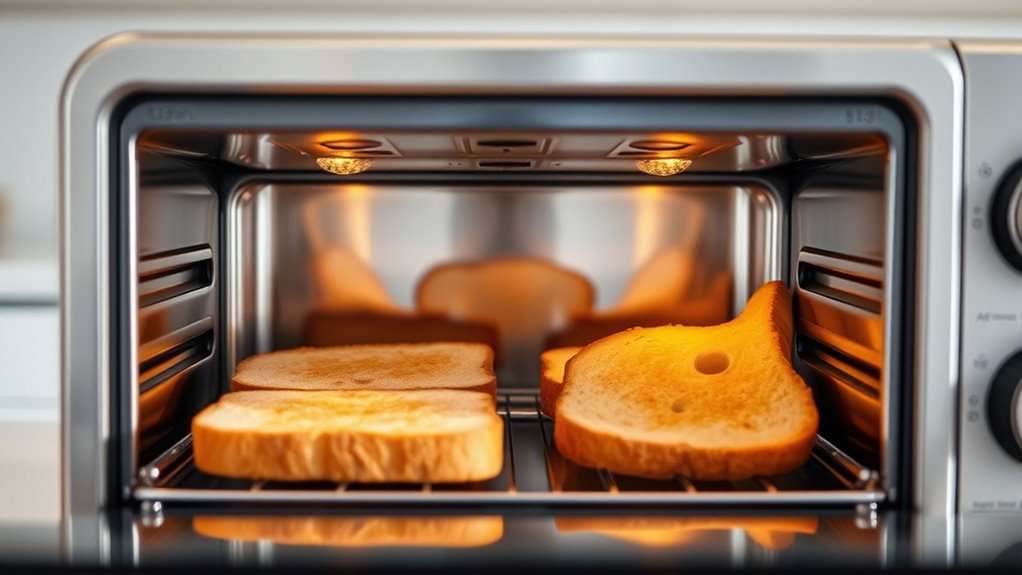
Understanding the role of temperature uniformity is essential to appreciating how a toaster oven functions effectively. When heat distributes evenly, your food cooks uniformly, avoiding hot spots and cold zones that can ruin the results. Proper heat distribution relies on good airflow design, which helps circulate air and maintain consistent temperatures. The placement of heating elements and quality insulation also influence oven performance, ensuring temperature control remains precise. If airflow is well managed, you’ll experience better cooking consistency, preventing burning or undercooking. Improved temperature uniformity enhances the overall performance of your toaster oven, making it easier to get perfect toast, baked goods, or roasted dishes every time. In short, even heat distribution is key to reliable and high-quality cooking results. Additionally, consistent temperature control is crucial for achieving predictable cooking outcomes and avoiding unexpected results. A well-designed airflow system and insulation quality are fundamental factors that contribute to maintaining temperature uniformity across the oven interior. Furthermore, understanding thermal dynamics can help users optimize their toaster oven settings for better results. Recognizing how heat transfer mechanisms operate within the oven can also lead to more precise adjustments and improved cooking experiences. Moreover, understanding the impact of air circulation can significantly improve cooking efficiency and outcome.
Factors Influencing Heat Distribution Within Toaster Ovens

The way heat is distributed inside a toaster oven depends heavily on the design and placement of its components. Your airflow, driven by convection fans and duct design, plays a vital role in heat distribution and temperature uniformity. The position of vents and baffles dictates airflow patterns, influencing how hot air circulates around your food. The heat source’s placement, whether on the top, bottom, or sides, affects evenness across the internal cavity. Insulation quality helps retain heat, preventing uneven temperature zones. Additionally, component placement and internal cavity size determine airflow pathways. Proper vent design and strategic component arrangement optimize airflow, ensuring more consistent heat distribution. These design considerations directly impact the toaster oven’s ability to deliver heat consistency, which influences how evenly your toaster oven cooks, directly impacting its performance and the quality of your results. Furthermore, understanding the importance of temperature uniformity can help in selecting models that deliver reliable cooking performance. Good airflow management and component placement are crucial for achieving even heat distribution, which is essential for consistent cooking results. Incorporating modern technology into toaster oven designs can further enhance heat control and distribution efficiency. Properly engineered airflow systems and thermal regulation components are key factors in achieving optimal heat distribution.
How Non-Uniform Heating Affects Food Quality and Cooking Results

When your toaster oven heats unevenly, it can lead to inconsistent results that affect both the appearance and texture of your food. Hot spots caused by poor airflow or faulty heating elements create uneven heat distribution, resulting in temperature disparities exceeding 18°C. These disparities can cause some areas to over-toast or burn while others remain undercooked, especially during baking. Uneven heat transfer prolongs cooking times and increases energy use, making it harder to achieve ideal results. Additionally, temperature variations can compromise food safety by preventing proper bacteria elimination. The lack of temperature uniformity impacts the overall cooking results, leading to uneven browning, texture issues, and compromised doneness. Proper heat distribution is essential for optimal food quality and safety. Regular maintenance and calibration of the heating elements can help improve temperature uniformity, ensuring consistent and safer cooking outcomes. Ensuring proper airflow within the oven can also mitigate hot spots and promote even heating throughout the cavity. Addressing heating element performance is crucial for maintaining consistent temperatures during operation. Additionally, incorporating advanced temperature sensors can further enhance the precision of heat regulation, leading to better cooking performance.
Techniques and Design Strategies to Enhance Temperature Consistency

To improve temperature consistency, focus on designing effective baffles and vents that direct hot air evenly throughout the oven. Optimizing airflow pathways with strategic placement reduces hot spots and cold zones, ensuring more uniform heating. Incorporating advanced control systems and CFD simulations can further refine airflow, resulting in better temperature regulation. Additionally, understanding air pollution and health impacts associated with uneven heat distribution can motivate the development of more sustainable and efficient toaster oven designs. Implementing smart sensor technology can also continuously monitor temperature variations and adjust heating elements in real-time, enhancing overall performance. Recognizing the importance of celebrity lifestyle insights can also inspire innovative features that enhance user experience and energy efficiency in appliance design. Moreover, integrating Kia Tuning principles such as airflow optimization can lead to more consistent heat distribution, drawing parallels from automotive performance enhancements. Exploring AI-driven innovations in appliance technology offers promising avenues for further improving temperature uniformity and overall efficiency.
Baffle and Vent Design
Effective baffle and vent design plays a crucial role in guaranteeing consistent temperature distribution inside toaster ovens. Proper baffle and vent placement direct hot air circulation, minimizing vortex formation and dead zones that cause uneven heating. Strategic vent placement and adjustable vents help balance airflow distribution, leading to improved temperature uniformity. Baffle design, including shapes and small holes or slots, promotes better airflow and reduces temperature gradients across the oven chamber. Incorporating flow-directing plates and removing obstructions near vents enhances hot air mixing, preventing hot spots and cold spots. Computational fluid dynamics (CFD) modeling guides ideal baffle shapes and vent locations, enabling airflow optimization. Additionally, understanding the airflow patterns within the oven allows designers to tailor baffle and vent configurations more precisely, resulting in even heating. Properly managed airflow also helps maintain consistent temperature levels throughout the oven cavity, reducing hot and cold spots. Recognizing how airflow interacts with oven components can further refine these design strategies, leading to higher performance and efficiency. Utilizing advanced design techniques, such as airflow modeling, can further improve the effectiveness of baffle and vent arrangements. Overall, these design strategies improve hot air circulation and ensure more consistent heating throughout the oven.
Airflow Optimization Techniques
Optimizing airflow in toaster ovens is essential for achieving consistent temperature distribution. You can improve temperature uniformity by carefully designing ductwork and vent placement to promote even hot air distribution and prevent flow stagnation. Incorporating adjustable baffles and vents directs hot air closer to your food, reducing temperature disparities. Increasing the recirculation fan speed by about 25% boosts airflow velocity, enhancing overall temperature consistency. CFD simulations are invaluable for identifying airflow patterns, vortices, and dead zones, allowing you to refine internal component placement. Proper sealing of the oven door and managing internal pressure prevent cold air ingress and hot air leaks, maintaining steady temperatures. By fine-tuning airflow pathways and ensuring proper vent placement, you optimize hot air circulation, resulting in more uniform heating and better cooking performance.
Evaluating the Impact of Improved Uniformity on User Satisfaction
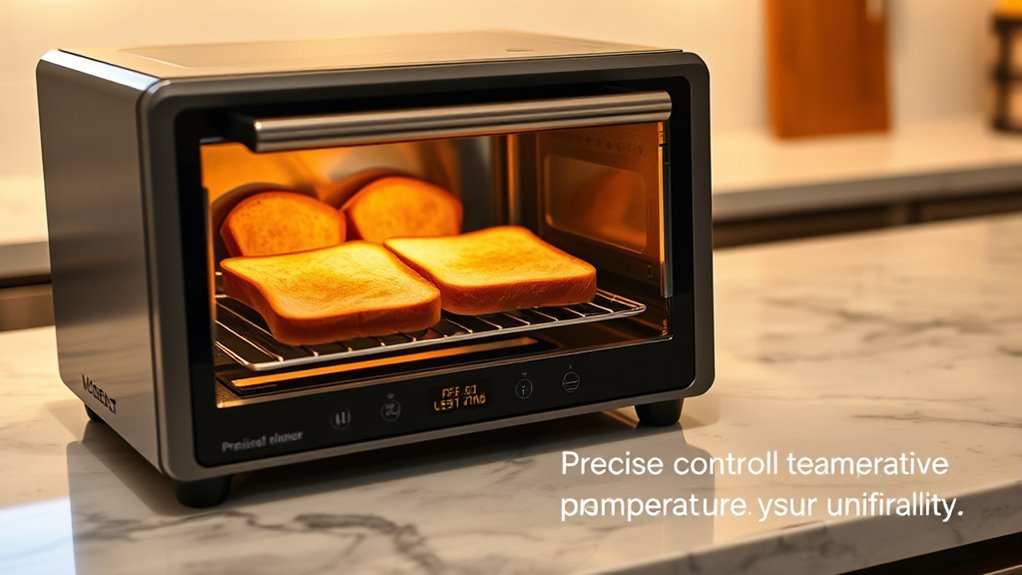
When toaster ovens achieve better temperature uniformity, user satisfaction tends to rise considerably. Improved uniformity enhances oven performance by ensuring consistent internal temperature and even hot air circulation within the oven chamber. With optimized airflow design and better insulation, toast becomes evenly browned, reducing uneven toasting from 20% to less than 5%, which consumers highly value. When the temperature control is precise, users experience fewer burnt edges or undercooked centers, leading to higher satisfaction. This consistency not only improves toasting but also makes baking and reheating more convenient, as fewer cycles are needed. Overall, refined temperature uniformity directly impacts user experience by delivering reliable toasting consistency and greater confidence in the oven’s performance.
Advances in Simulation and Testing for Optimizing Oven Heat Distribution

Advances in simulation and testing have revolutionized how manufacturers improve heat distribution inside toaster ovens. Using computational fluid dynamics (CFD), you can model airflow and heat transfer with high precision, identifying areas prone to hot spots. Thermal analysis helps evaluate how design changes, like baffle adjustments and airflow path improvements, enhance temperature uniformity. Testing, combined with detailed simulation, verifies how modifications affect oven performance, ensuring more even air distribution and consistent heating. By analyzing temperature measurements at multiple points, you gain insights into real-world oven behavior. These tools enable you to optimize internal airflow patterns, minimize temperature gradients, and improve overall oven performance. As a result, modern simulation and testing methods lead to toaster ovens with better heat distribution and more reliable, uniform cooking results.
Future Trends and Innovations in Toaster Oven Temperature Management
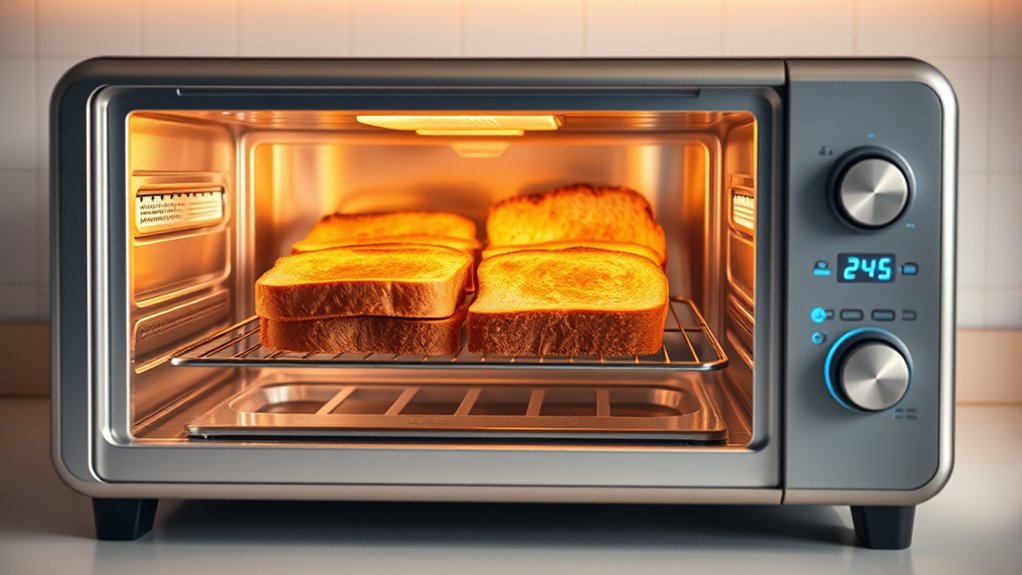
Emerging technologies are set to revolutionize how toaster ovens manage temperature, building on recent advances in simulation and testing. You’ll see convection fans and airflow management systems, like adjustable fans and dynamic ducting, improve temperature uniformity across zones. Precise temperature sensors and sensor technology enable real-time monitoring, reducing temperature gradients. New thermal insulation materials with higher thermal efficiency keep heat transfer consistent, minimizing heat loss. Integration of smart connectivity and machine learning allows adaptive control systems to automatically adjust heating profiles based on food type and load, ensuring stable internal temperatures. These innovations mean you’ll enjoy more consistent cooking results and better energy efficiency.
| Technology | Benefit |
|---|---|
| Convection fans | Improve airflow management, uniform heat transfer |
| Temperature sensors | Enable precise real-time temperature monitoring |
| Thermal insulation | Minimize heat loss, stabilize internal temperatures |
| Adaptive control systems | Automatically adjust for ideal temperature uniformity |
Frequently Asked Questions
Is Baking in a Toaster Oven the Same as Baking in an Oven?
Baking in a toaster oven isn’t quite the same as in a traditional oven. You might notice uneven cooking, requiring you to rotate or reposition your food frequently. The smaller chamber and limited airflow can cause temperature fluctuations, affecting your baked goods’ consistency. While both appliances can handle similar recipes, expect a bit more attention and adjustments with a toaster oven to achieve even results.
What Is the Equivalent of 350 in a Convection Oven?
Think of your convection oven as a well-orchestrated symphony; it cooks faster and more evenly. For an equivalent of 350°F in a standard oven, you should set your convection oven to around 325°F to 340°F. This slight drop accounts for the enhanced heat transfer from the fan. Adjusting the temperature guarantees your baked goods turn out just right, like a perfectly tuned instrument.
Do Toaster Ovens Run Hotter Than Regular Ovens?
You might notice that toaster ovens often run hotter than regular ovens. Since they have smaller sizes and less insulation, they heat up quickly and can reach higher temperatures faster. Plus, their heating elements are closer together, which can create hotspots and uneven heat distribution. With higher maximum temperature settings, you could be cooking at hotter temperatures, making your toaster oven feel hotter overall compared to traditional, larger ovens.
What Is the Temperature Range for a Toaster Oven?
Did you know most toaster ovens can reach up to 480°F, enough to perfectly toast bread or bake small dishes? The temperature range typically spans from 75°F to 480°F, with some models going higher. You can precisely adjust the heat for different tasks, from gentle warming to high-temperature baking. This versatility makes toaster ovens a convenient option, offering control within a broad range for various cooking needs.
Conclusion
By mastering temperature uniformity, you turn your toaster oven into a symphony of even heat, transforming each meal into a masterpiece. When the heat dances harmoniously across the chamber, you’ll taste the difference—crispy crusts, perfectly cooked centers, and culinary satisfaction that rises like a well-crafted melody. Embrace the innovations and techniques shaping this harmony, and watch your cooking elevate from mere function to an artful performance.
